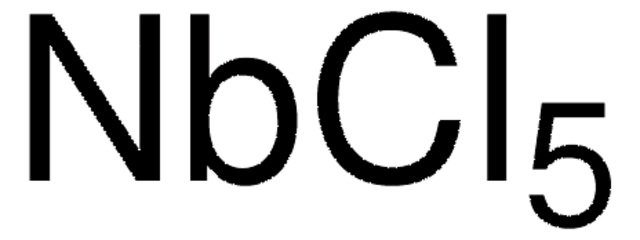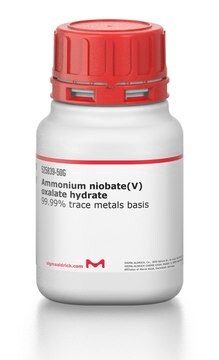203920
Niobium(V) oxide
99.99% trace metals basis
Synonym(s):
Niobium pentoxide
Sign Into View Organizational & Contract Pricing
All Photos(4)
About This Item
Empirical Formula (Hill Notation):
Nb2O5
CAS Number:
Molecular Weight:
265.81
EC Number:
MDL number:
UNSPSC Code:
12352303
eCl@ss:
38180502
PubChem Substance ID:
NACRES:
NA.23
Recommended Products
Quality Level
Assay
99.99% trace metals basis
form
powder
density
4.47 g/mL at 25 °C (lit.)
SMILES string
O=[Nb](=O)O[Nb](=O)=O
InChI
1S/2Nb.5O
InChI key
ZKATWMILCYLAPD-UHFFFAOYSA-N
Looking for similar products? Visit Product Comparison Guide
Related Categories
General description
Niobium(V) oxide, also known as niobium pentoxide, is a white crystalline powder. It is a refractory metal oxide with a high melting point of over 2500 °C and high chemical stability, including to oxygen and moisture. Niobium(V) oxide is mainly used as a raw material in the production of niobium and niobium alloys, as a catalyst in chemical reactions, and as a refractory material in high-temperature applications. It is also used as a dielectric material in capacitors and as a pigment in ceramics and glasses.
Application
Applied in the solid state formation of an unusual cation deficient perovskite, Ba7Nb4MoO20.
Promising results were obtained using niobium(V) oxide as an alternate electrode to lithium metal in advanced fuel cells.
Features and Benefits
Applied in the solid state formation of an unusual cation deficient perovskite, Ba7Nb4MoO20.
Storage Class Code
11 - Combustible Solids
WGK
nwg
Flash Point(F)
Not applicable
Flash Point(C)
Not applicable
Personal Protective Equipment
dust mask type N95 (US), Eyeshields, Gloves
Choose from one of the most recent versions:
Already Own This Product?
Find documentation for the products that you have recently purchased in the Document Library.
Garcia-Gonzalez, E. et al.
Chemistry of Materials, 11, 433-433 (1999)
Hye-Na Kim et al.
ACS applied materials & interfaces, 4(11), 5821-5825 (2012-11-17)
This paper describes the use of Nb₂O₅-coated TiO₂ 3D ordered porous electrodes in dye-sensitized solar cells. We employed bilayer inverse opal structures as a backbone of 3D porous structures, and the number of Nb₂O₅ coatings was controlled, determining the concentration
Edmar Martendal et al.
Journal of hazardous materials, 161(1), 450-456 (2008-05-06)
In this study a new method for chromium speciation in water using solid phase extraction coupled to a flow injection system and flame atomic absorption spectrometry was developed. The adsorption behavior of Cr(III) and Cr(VI) on Nb2O5-SiO2 allowed the selective
Robert L Karlinsey et al.
Bioinspiration & biomimetics, 1(1), 12-19 (2007-08-03)
The formation aspects of a polycrystalline self-assembled bioceramic leading to the nucleation of hard-tissue mineral from a supersaturated solution are discussed. Scanning electron imaging and surface-sensitive interrogations of the nucleated mineral indicated the presence of an intermediate amorphous layer encompassing
Y B Kiran et al.
Journal of agricultural and food chemistry, 55(17), 6933-6939 (2007-07-31)
Synthesis of some new substituted [3-(3-chloro-4-fluorophenyl)-2-oxo-3,4-dihydro-2H-2lambda(5)-benzo[e][1,3,2]oxazaphosphinin-2-yl]-(aryl/alkyl)methanols (7a-k) based on the Pudovick reaction was accomplished in the presence of niobium pentoxide (Nb(2)O(5)) without using an external chiral ligand. Nb(2)O(5) appears to form the metal complex intermediate catalyst system (6) by reacting
Articles
The prevailing strategies for heat and electric-power production that rely on fossil and fission fuels are having a negative impact on the environment and on our living conditions.
Global Trade Item Number
| SKU | GTIN |
|---|---|
| 203920-250G | 4061838766519 |
| 203920-10G | 4061838766502 |
| 203920-50G | 4061838766526 |
Our team of scientists has experience in all areas of research including Life Science, Material Science, Chemical Synthesis, Chromatography, Analytical and many others.
Contact Technical Service







